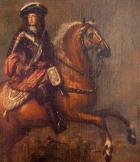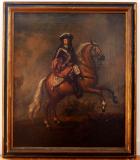The painting shows William III leading his troops at Battle of the Boyne, 1690
William III, king of England and prince of Orange–Nassau, is famous in history as the ruler who rallied the forces of Europe against French hegemony under Louis XIV, king of France. Overcoming adversity was a lifelong task for William. He was born the only son of William II, prince of Orange and stadtholder of the Dutch Republic (an elective not hereditary office in the United Provinces, the official name of the Dutch Republic between 1578 and 1815), and Mary Stuart, daughter of Charles I. William’s birth occurred eight days after his father’s death. The death came a week after a failed coup wherein his father had sought to strengthen his position. His mother’s family was in exile during this the period of the Commonwealth (1649–60). The result of the death and failed coup d’etat was that the anti-Orange faction, the oligarchy of rich merchants primarily based in Holland and led by the De Witt brothers, seized control and abolished the office of stadtholder. William saw his mother’s family restored to power in England in 1660 but lost his mother later that year. Now an orphan, he awaited his chance. It came when Louis XIV made a sudden attack on Dutch territory in revenge for Dutch diplomatic attempts to block his aggrandizement in the Netherlands. The De Witt regime was overthrown, and William was made stadtholder, captain-general, and admiral for life.
In the struggle for survival, although France had the military advantage, he had the diplomatic triumph of securing aid from Brandenburg, Austria, and Spain. The breakthrough came when England switched sides and he married his cousin Mary, daughter of the duke of York, in 1677. Although France made gains elsewhere, the Dutch Republic and most of the Netherlands were saved from the French. William organized the League of Augsburg in opposition to French annexations in Germany and the Low Countries. His major triumph came when the English opposition to his father-in-law (now James II) approached him in 1687. In return for supporting the rights of Parliament and opposing the pro-Catholic religious policies of James II, they promised him the throne. William landed in England in 1688, overthrew James II, and defeated his adherents at the Battle of the Boyne in 1690. The political result was the Glorious Revolution of 1688, which led to the formal supremacy of Parliament. Thereafter, he and his wife, Mary, third and first in the line of succession, were declared sovereigns as William III and Mary II. His position had become so secure that he was able to rule after the death of Mary in 1694, even though her sister Anne was closer in line of the succession.
William’s domestic policies were not especially successful, as he remained focused on external affairs. The major blot on his record during the 1690s was the massacre of the MacDonald clan in Glencoe, Scotland, wherein the perpetrators were rewarded. His achievements during the 1690s were in the Wars of the League of Augsburg, which lasted from 1689 to 1697 and forced Louis to give up all acquisitions gained during the war. The prospect that Spain and all its possessions would fall to France on the death of Charles II in 1700 threatened to undo his efforts to create a balance of power in Europe. Once again, he rallied much of Europe against France to prevent Louis XIV from becoming a new Charles V. The subsequent War of the Spanish Succession (1702–13) did eventually accomplish this result. William, however, was not there to see it, as he died in March 1702 after a fall from his horse. Rarely successful in war, but almost always in diplomacy, he had as his main achievement the idea of a balance of power as necessary for European security. William was the author of a precursor to the idea of collective security but did not live to see its first application in the Peace of Utrecht in 1713.
Wyck [Wijck], Jan [Jan van, John] (c.1645–1700), painter, was born in Haarlem, the son of Thomas (van) Wyck (c.1616–1677), also a painter. Wyck made his name in England as a specialist at painting horses in battle and hunting scenes, topographical and classical landscapes, and portraits of people, animals, and buildings. He brought the Dutch equestrian portrait genre to England. His oil studies of individual horses are perhaps his most original contribution to the history of English art.
Thomas Wyck had visited Rome in the 1630s, and his paintings and drawings show small figures in Mediterranean street or harbour scenes. He also specialized in Dutch domestic interiors and alchemists' laboratories. He had married in Haarlem on 22 May 1644, and came to Englandc.1664 where he drew and painted views of London, and night scenes of the great fire. It is assumed that Thomas, who took other pupils, taught Jan his art, but it is not known exactly when Jan arrived in England. On 17 June 1674 Jan promised to present his ‘proofe peece’, and pay his own and his father's quarterly fees to the Painter–Stainers' Company in the City of London. On 24 November 1680 he was placed upon ‘The Committee of Acting Painters’ of the company (City of London, Guildhall MS 5667/2, pt 1, fols. 170, 58). By then Thomas had returned to Haarlem where he died and was buried on 19 August 1677.
Jan Wyck married three times. Nothing is known about his first wife, but he was a widower aged about thirty-one and living in St Paul's, Covent Garden, when he married Ann Skynner, aged nineteen, of St Martin-in-the-Fields, on 22 November 1676 in St Mary Savoy. Between 1678 and 1683 they had four children, but none survived and Ann died in 1687. On 9 August 1688 he married Elizabeth Holomberry, aged about twenty-two, and went to live with her in Mortlake, Surrey. They had three children: first John (b. 1689) and William (b. 1691), but then Elizabeth died giving birth to her namesake in April 1693. Wyck himself died on 26 October 1700 in Mortlake.
Wyck's oil paintings on canvas and panel show skill, vigour, and versatility. There are probably more than 150 still in existence. The battle scenes for which he was most famous owe a debt to Philips Wouwermans (1618–1688) and Jacques Courtois (Il Bourgognone; 1621–1676), and are not dissimilar to the canvases of Adam Frans van der Meulen (1632–1690). Wyck's paintings are attractively coloured and endlessly varied, depicting in the near ground horsemen and foot soldiers in violent action, flourishing swords or firing muskets, with cannon smoke and tiny fighting figures receding into an atmospheric distance. Some depict Turks with moustachios, turbans, and scimitars, reflecting contemporary interest in the Austrian–Turkish wars. Pictures which included recognizable commanders, such as William III, often at the battle of the Boyne (numerous versions) or the siege of Namur (unfinished picture at National Army Museum, London), were much in demand. He painted one of the earliest depictions in colour of official military uniform, a portrait of Colonel Randolph Egerton seated on a fine grey horse (priv. coll.).
Wyck's hunting pieces are more repetitive, the English countryside generalized and freshly green. He painted Sir Gilbert Coventry, one of his last patrons, with his own horses and hounds in a picture still at Antony, Cornwall (priv. coll.). He also depicted imagined scenes of Mediterranean seaports and Italian capricci, as well as particular topographical views of England such as Windsor Castle, the city of Leicester, and Whitehaven docks. He took commissions for country house portraits such as Sprotborough Hall, Yorkshire, and made studies of animals for their owners, for instance a black bull mastiff in front of Dunham Massey Hall, Cheshire (Dunham Massey). His picture A Gray Stallion Tethered to a Post (ex Sothebys, 12 July 1995) is one of the earliest English horse portraits which would become so popular with country gentlemen.
Wyck's clients were illustrious. A portrait of James, duke of Monmouth, the king's eldest son, dated c.1673, is probably his earliest English portrait (priv. coll.). Monmouth commissioned four depictions of his campaigns, and paid Wyck £30 in 1676 (BL, Sloane MS 1985, fols. 95–95v). The duke and duchess of Lauderdale acquired several scenes by Thomas Wyck for Ham House, Petersham, Surrey, and a battle piece by Jan Wyck; they all remain in situ. Wyck drew up a valuation list of paintings for the duchess, who pawned some pictures with him in 1686 (see Laing and Strachey, 7). The duke of Grafton possesses Wyck's view of a hunt in front of Euston Hall, Suffolk (1677). The duke of Norfolk was twice painted riding a white horse by Wyck: to the artist's normal scale (priv. coll.) and life-size at Drayton House, Northamptonshire. Three scenes of cavalry engagements also hang at Drayton. There are many equestrian portraits by Wyck of William III (one, dated 1692, still hangs at Blenheim Palace, Oxfordshire).
There was only one battle scene by Wyck in the Royal Collection in 1688 (BL, Harley MS 1890, fol. 85v), but a small bronze modello of Charles II on horseback by William Larson (National Gallery of Ireland, Dublin) bears the inscription: ‘Baxter taught Wyck Drew Larson Embost & Cast it tow’. Wyck kept in touch with Gerrit Uylenberg, ‘Purveyor of His MatiesPictures’, until the end of his life (Millar, 540). One ‘Jan van Wijck’ was taken to Holland in 1682 to ‘help … find out horses’ for the queen (TNA: PRO, warrants not relating to money, T54/9, fol. 174).
Wyck's lively designs of country pursuits appeared as engravings in Richard Blome's The Gentleman's Recreation (1686). Two of his preparatory drawings for Blome are in the British Museum, along with his drawing of The Thames During the Great Frost of 1683/4. In John Slezer's Theatrum Scotiae (1693) Wyck had the task of ‘touching and filling up … 57 draughts with little figures at 10 shillings sterlin per piece’ (Cavers, 9). Three of these draughts are in the Ashmolean Museum, Oxford. The Yale Center for British Art has a watercolour by Wyck of a stag hunt (Paul Mellon collection), and the Royal Collection a brush drawing of fishermen by a lake.
In 1685 Godfrey Kneller painted a portrait of Wyck (now lost) engraved in mezzotint in 1730 by John Faber junior. Faber also engraved Wyck's battle and hunting scenes, as did John Smith and Bernard Lens. Matthias Read and Sir Martin Beckman, an amateur artist, were both Wyck's pupils, and also John Wootton in the late 1690s. Wootton's early style is difficult to distinguish from his master's. Wyck signed his works with a monogram ‘JW’, or ‘J. Wyck’ or ‘Jan van Wijck’. Examples of his work are held in the Ulster Museum, Belfast; the National Gallery of Ireland, Dublin; the National Maritime Museum, Greenwich; the Polish National Museum, Warsaw; the Royal Collection, Victoria Gallery, Bath; Temple Newsam House, Leeds; and various private collections.
Katharine Gibson DNB



